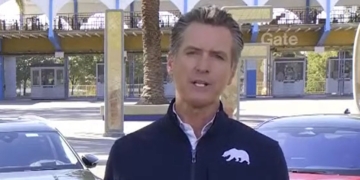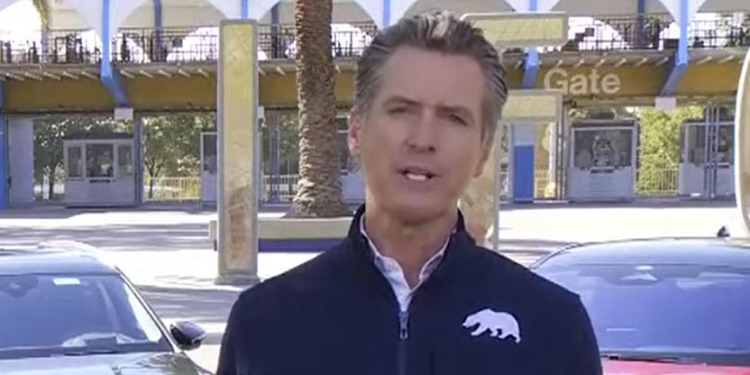There was a remarkable back and forth recently between Nevada Gov. Joe Lombardo and California Gov. Gavin Newsom over California’s culpability for high gasoline prices on the West Coast.
Lombardo sent Newsom a letter expressing concern over yet another California tax on energy, 2023’s SB X1-2 (the unartfully named California Gas Price Gouging and Transparency Law) and its spillover effects on Nevada, which gets 88% of its fuel from refineries in California.
California already has the nation’s highest gasoline prices, currently averaging $5.03 per gallon compared to the national average of $3.52. This is due to hefty taxes and stringent environmental regulations such as the cap-and-trade program and the low-carbon fuel standard.
While these measures aim to reduce pollution as well as CO2 emissions, they also lead to significant price volatility. The unique blend of gasoline required in California, designed to cut emissions, creates a small, specialized market. Any disruptions in supply — whether from refinery issues or regulatory changes — can send prices soaring.
I was the vice chairman of the California Assembly’s Committee on Revenue and Taxation for a few years. This gave me a front row seat to what has been decades of political blame shifting, where Democrats accuse “Big Oil” of price-gouging when it’s the politicians’ decisions that have caused higher gasoline prices.
Of course, the price fixing accusations have never been substantiated despite numerous show hearings disguised as investigations.
Newsom’s responded to his neighbor with a letter to the editor in the Wall Street Journal, painting a self-portrait of a hero standing up to “Big Oil” for the benefit of Californians. But this tale obscures the reality of the tradeoffs inherent in California’s energy policies, which result in higher costs for consumers — both within and beyond the Golden State’s borders.
Newsom’s response to Lombardo’s concerns about rising gasoline prices causing pain at the pump in Nevada and Arizona exemplifies the problem. Rather than addressing the issues raised—such as the impact of California’s policies on neighboring states — Newsom dismissed them as “Big Oil” talking points. This deflection ignores a fundamental economic principle: supply and demand.
When California imposes new taxes or regulations on refineries, the costs inevitably flow to consumers. This isn’t just about profits; it’s about the basic mechanics of supply and demand. If refineries close or reduce output due to unmanageable operating costs, supply dwindles, and prices rise. This is not an abstract theory — it’s Economics 101.
Moreover, California’s political class sees high gasoline prices as a covert ally in its war against internal combustion engines. High prices discourage gasoline consumption, aligning with the elite’s ambitious environmental goals.
Yet, this approach doesn’t consider the practical challenges of transitioning to electric vehicles (EVs) for most Californians. Without federal subsidies, the cost of owning and operating an EV remains prohibitive.
Furthermore, the state’s electrical infrastructure is nowhere near ready to support a full-scale shift to EVs. The necessary upgrades to local grids, power plants, and transformers are not just expensive—they are staggering, with estimates reaching over $1 trillion nationally by 2035 to power an EV fleet amounting to only 10% of all vehicles.
Critics rightly argue that the EPA’s new standards for carbon-dioxide emissions, which essentially mandate a significant increase in EV sales, are unrealistic. Current infrastructure and production capabilities are insufficient to meet these demands.
The replacement of millions of electrical transformers, necessary to support widespread EV adoption, is alone a monumental task that will take years and vast resources to accomplish. This doesn’t even account for the additional strain on the grid from the increased power demand of EV charging stations, which would require upgrades comparable to powering entire towns.
You think transportation costs are high now in California? Wait until the state’s mandate to ban internal combustion engines takes effect in 2035.
Newsom’s policies fail to consider these broader impacts and tradeoffs. Protecting consumers from price spikes and fostering a more transparent gasoline market are commendable goals. However, the approach should not ignore the economic realities that make gasoline prices in California a result of broader systemic issues.
The state’s high taxes and regulatory environment are significant factors driving these costs.
Public policy is about tradeoffs. California’s drive to clear its skies and reduce emissions comes with the costs of higher gasoline prices and strained infrastructure. Accusing the oil industry of price gouging without addressing the supply constraints created by state policies is a disservice to Californians.
It is time for elected leaders to account for economic realities and infrastructure needs, ensuring that environmental goals are both achievable and do not come at an unsustainable cost to consumers — a cost in lost jobs, outmigration, and the rotten fruits of despair.
Newsom’s blame-casting act is worse than wrong — it is old.
Chuck DeVore is Chief National Initiatives officer at the Texas Public Policy Foundation. He served in the California State Assembly and is a lieutenant colonel in the U.S. Army Reserve. He’s the author of “Crisis of the House Never United.”
The views and opinions expressed in this commentary are those of the author and do not reflect the official position of the Daily Caller News Foundation.
(Featured Image Media Credit: Screen Capture/ABC7 News Bay Area)
All content created by the Daily Caller News Foundation, an independent and nonpartisan newswire service, is available without charge to any legitimate news publisher that can provide a large audience. All republished articles must include our logo, our reporter’s byline and their DCNF affiliation. For any questions about our guidelines or partnering with us, please contact [email protected].



























 Continue with Google
Continue with Google